Butter and vodka are the secret ingredients to a pie crust that is flaky, tender, and great tasting! With this easy-to-make Butter and Vodka Pie Crust recipe, you will have better-than-bakery pies every time!
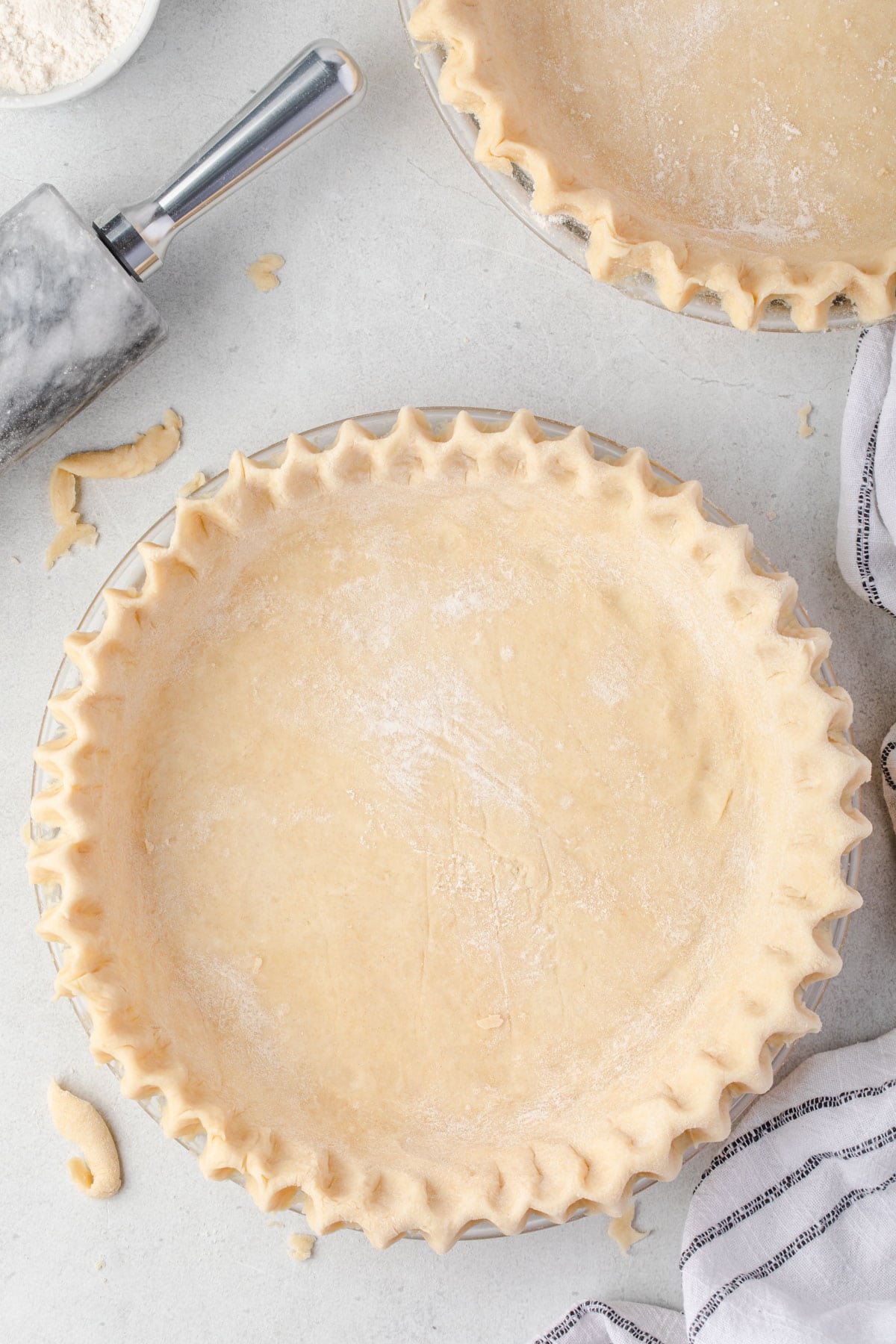
"Made as written. Yum. Certainly the best recipe I’ve ever tried. This will be the only recipe I ever make. I’m in my seventies and gave up making home made crusts decades ago. Mine we’re not as good as store bought. Now my home made pies will be really home made. Thank you for sharing such a precise recipe."
- Fox
I used to think store-bought crust worked just fine for pies. But then I learned how a secret ingredient magically makes the flakiest homemade pie crust that is hands down better than anything you could buy at the grocery store.
Why You Will Love This Pie Crust
- Tender and flaky pie crust - Little pockets of butter are wrapped in flour, creating flaky layers.
- Works for sweet or savory pies - Whether you are making a Thanksgiving Sweet Potato Pie or a savory pot pie or quiche, this is a perfect pie crust that you can rely on to turn out every time.
- No soggy bottom crust - When your pie crust has too much liquid in it, the crust can end up soggy. Vodka evaporates faster than water, so you will never have a soggy crust!
- Makes a great topping - It's not just for pies! This crust makes an incredibly flavorful cobbler topping too! Try it with this Peach Pie Cobbler recipe!
Simple Ingredients
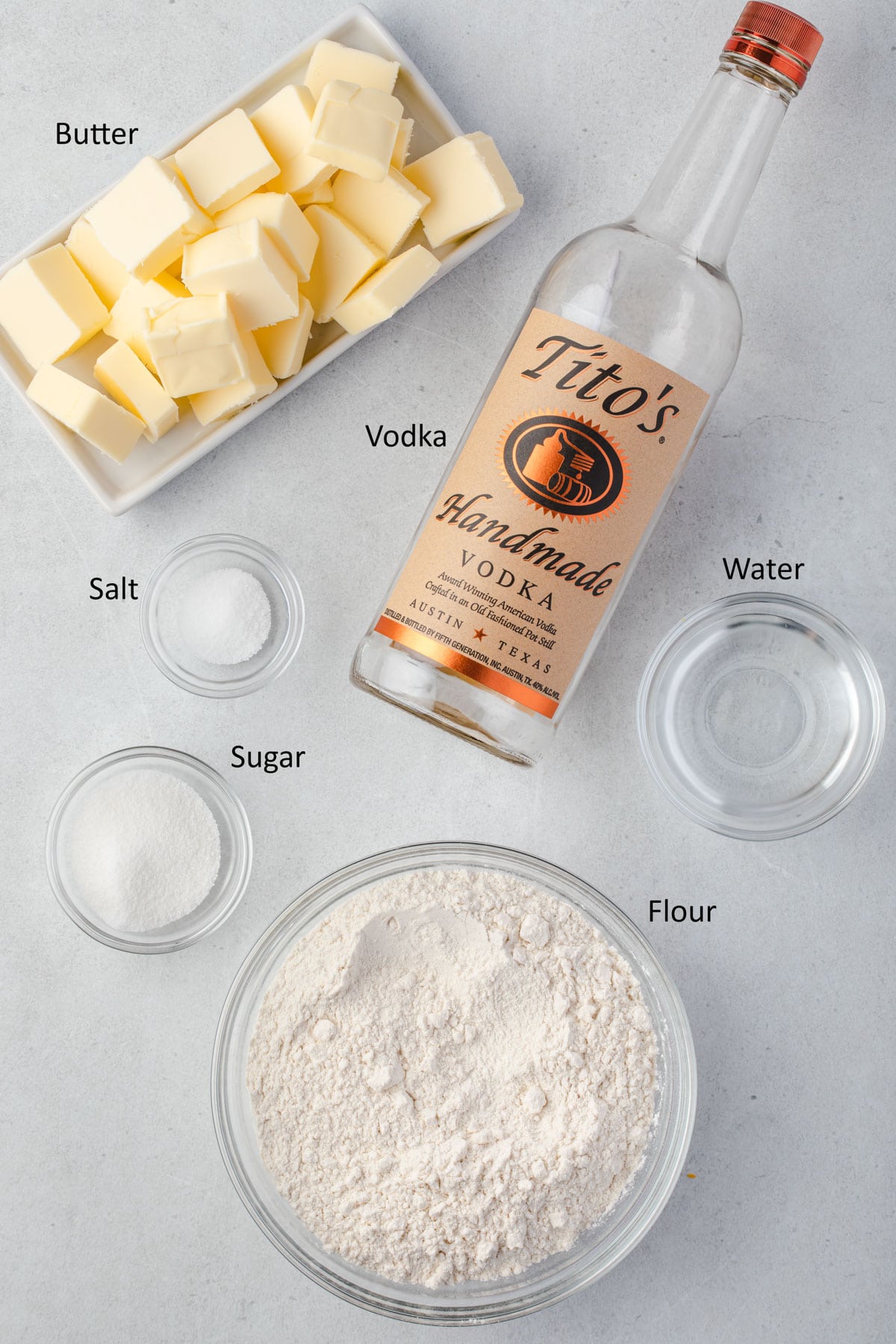
Flour: All-purpose flour is best for pie crust. When measuring your flour, either weigh it with a scale or measure by spooning the flour lightly into a measuring cup. Never scoop the flour from the bag with your measuring cup, or you will end up with too much flour.
Butter: Some pie dough recipes call for vegetable shortening, which they say is essential for a flaky crust. But using only butter has a better flavor, so instead of relying on shortening for flakiness, we utilize technique. The steps for this pie dough result in a super flaky, flavorful, all-butter pie crust.
Water: All ingredients, including the water, should be cold. For best results, add ice cubes to a cup of water while you prepare the flour and butter, then measure out ¼ cup of ice water right before adding it to the dough.
Vodka: This is the secret ingredient that adds hydration to the dough without activating the formation of the gluten. The result is the most tender pie crust that is never tough.
How to Make Vodka Pie Dough
- Mix half of the flour with the salt and sugar in a food processor using one-second pulses.
- Add the cold butter and pulse quickly until it is the size of cottage cheese curds. If you do not have a food processor, you can use a pastry blender.
- Scrape the bowl, add the remaining flour, and pulse the food processor about 5-6 times until the flour is mixed in. Adding the flour in 2 stages helps reduce the gluten formation and avoid overworking the dough.
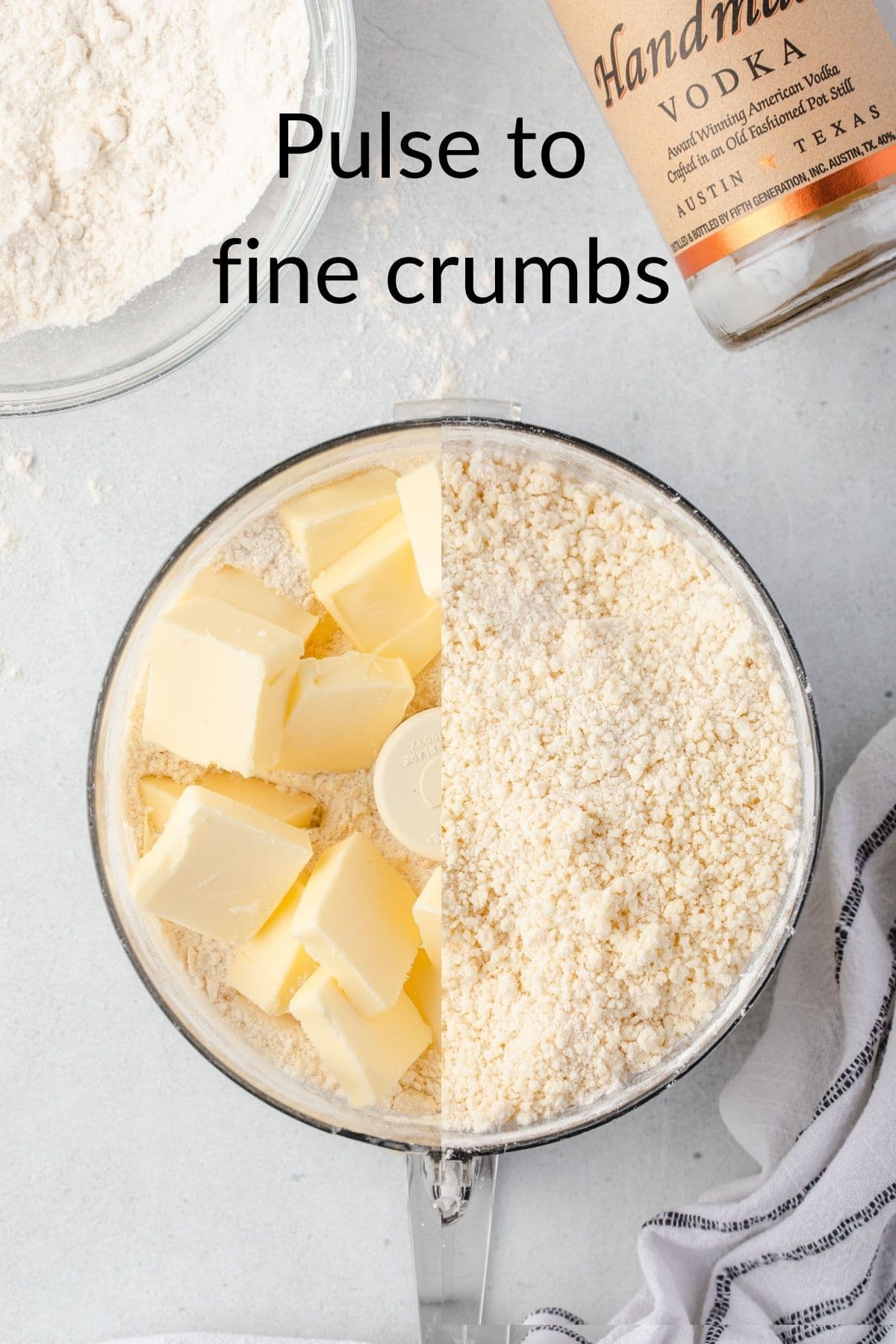
- Transfer the flour mixture to a medium bowl and sprinkle chilled vodka and ice-cold water over the top.
- Press the liquid into the dough using a rubber spatula.
- The dough will be shaggy. Smash the dough, scoop under it, fold it over the top, and smash it again until it looks like the photo below on the right.
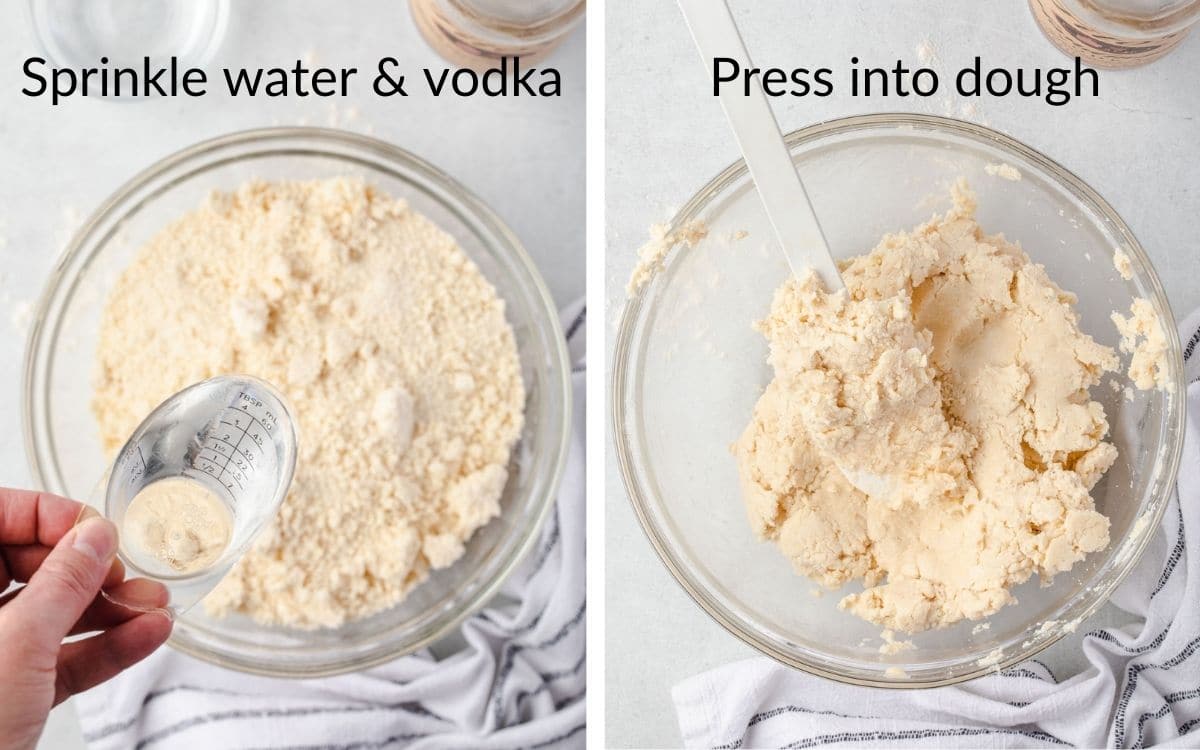
- Divide the dough into two portions and shape each into a 4-inch disk. Wrap them in plastic wrap and refrigerate for 2 hours.
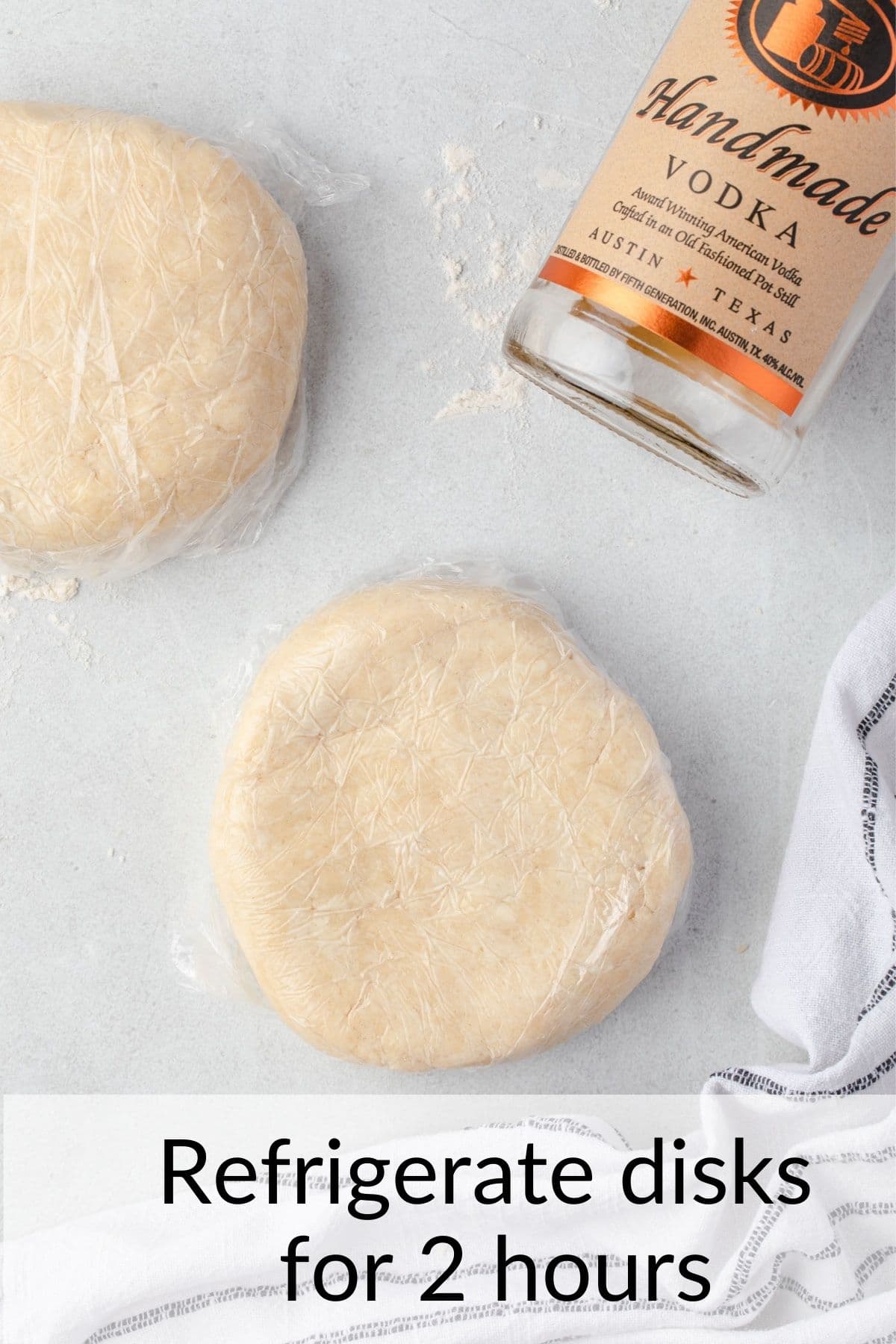
Tips for Rolling the Dough
- Use a rolling pin to roll the dough on a well-floured surface. I like to flour parchment paper, roll it on the paper, and then use that paper to transfer the dough to a 9-inch pie plate.
- Sprinkle the top of the dough disk with flour as well. You can also add a sheet of parchment to the top of your dough, rolling the dough out between the two sheets to avoid sticking to your roller.
- Roll it ⅛-inch thick. This should be about 12 inches in diameter.
- Transfer the dough to your plate and fold the excess under to create your crust edge.
- Trim off any excess dough, then crimp the edges using your favorite style.
- For double-crust pies, place the second sheet of dough on top of the filling, bring the bottom layer up over the top, and then crimp together. Cut a few slits in the top for steam to escape.
- You can also cut the dough into strips for a lattice crust, like in my Cherry Rhubarb Pie recipe.
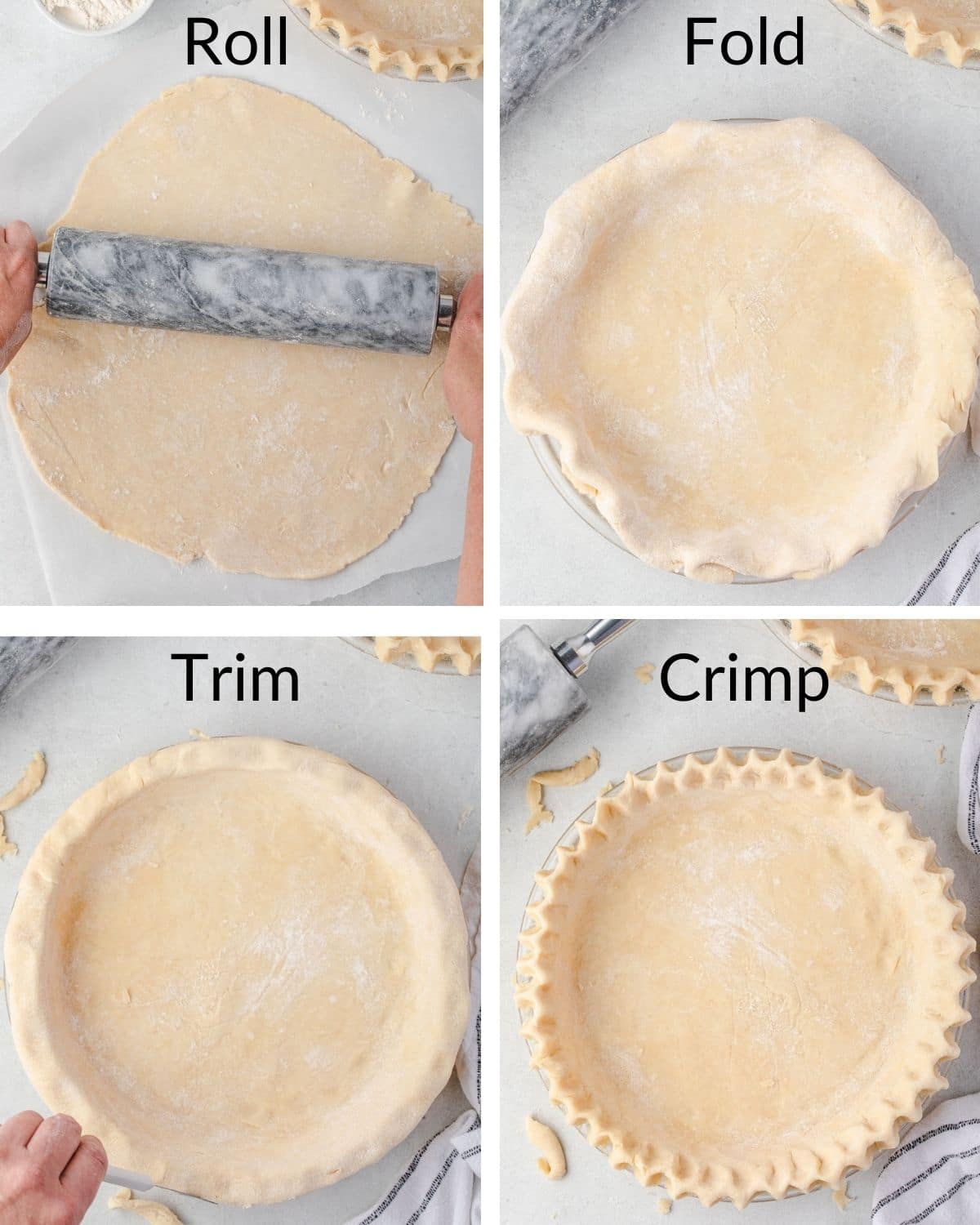
How to Par-Bake Your Crust
Blind baking is also called par-baking. It is the process of partially baking a pie crust. I almost always par-bake my single-crust pies. I love the results!
- Prick holes in the bottoms and sides of your pie crust.
- Cut out a parchment paper circle and gently press it on the dough.
- Fill the parchment-lined crust with pie weights or dry beans.
- Bake at 425°F for 15 minutes. Remove the pie from the oven and remove the parchment and pie weights. (I pinch the edges of the parchment together to make a little cup, then remove the pie weights to a bowl. Be careful, as they will be hot!
- Reduce the oven temperature to 350°F and bake an additional 5 minutes, or until the bottom of the crust looks dry and baked but not yet browning.
- If you are baking a crust for a no-bake pie, like Chocolate Cream Pie, bake for 10-15 minutes once the pie weights are removed.
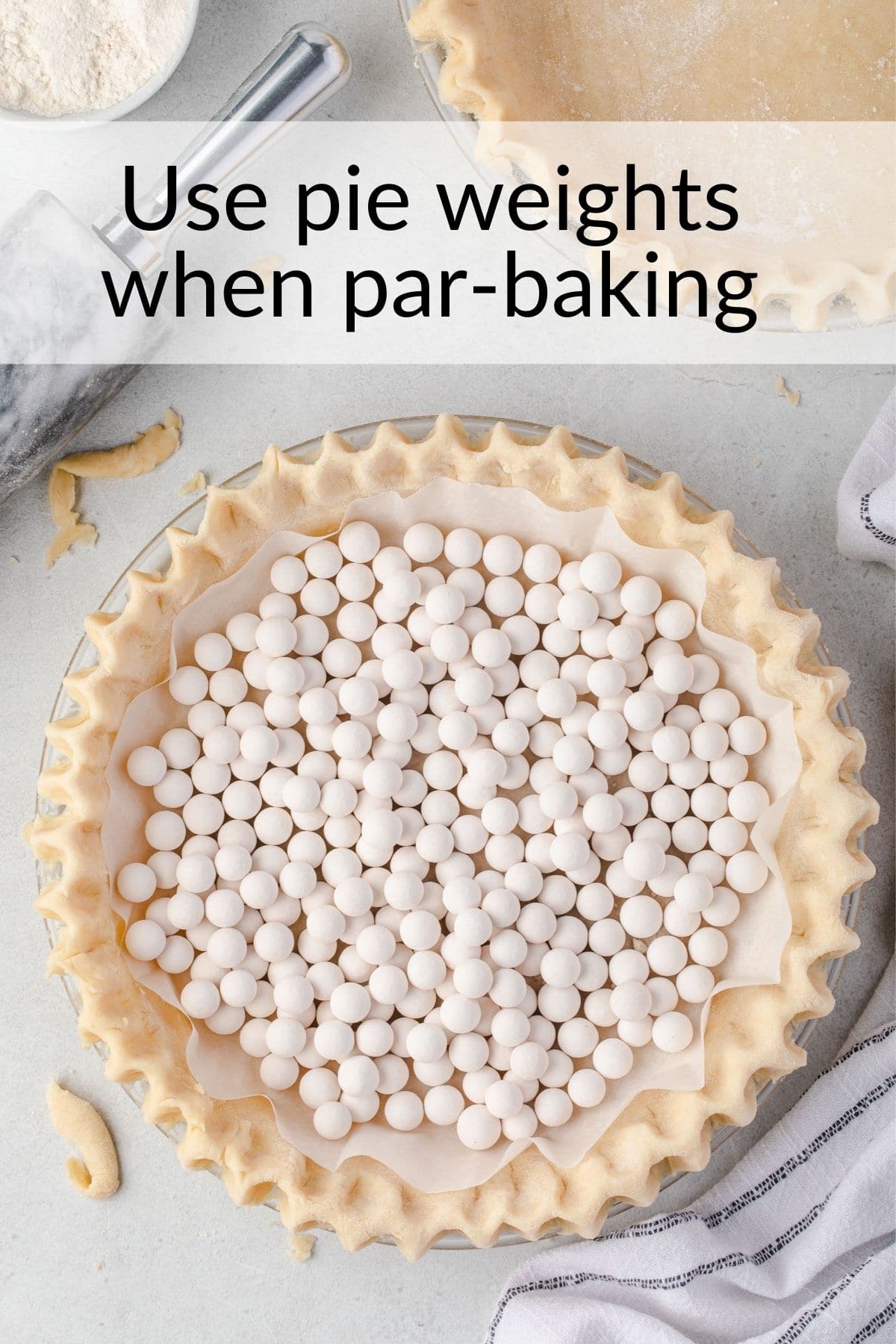
Expert Tips
- Keep your ingredients cold. This is the most critical step in creating the best pie crust! From the moment you mix your flour to when you put the pie into the oven, you must have one question: Are my ingredients cold? Some people even put their bowl and flour into the freezer!
- Freeze the dough. To keep your ingredients cold, put your pie crust in the freezer for 10 minutes after you prepare it in the pie plate. This will help keep the sides from slipping, as the butter won't melt until the flour has started to bake. If you don't have room in your freezer, you can place it in the refrigerator for 30 minutes instead.
- Do not overwork the dough. Handle the dough as little as possible. This starts with step 1, where the salt and sugar are mixed with the flour. Use the pulse feature on your food processor rather than mixing at full power so that you have control over exactly how much is mixed. The more you work the dough, the more gluten is formed, which is the number one reason for a pie failure.
- Press the liquids into the dough. At first, you might think the dough is too crumbly, but once you press the liquids in, it will start to stick together.
Recipe FAQs
Yes, the disks of pie dough can be frozen for up to 5 months. Thaw in the refrigerator overnight before baking. You can also store fresh pie dough in the refrigerator for up to 5 days.
If the butter gets too warm too fast, the dough will contract, causing your pie crust to shrink. To reduce this, freeze or refrigerate your dough before putting it in the oven. Also, pressing the dough firmly against the edge of the pie plate will make a seal that will help reduce shrinking.
If you would like to use shortening in your pie crust, I recommend using ¼ cup of shortening and 12 tablespoons of butter.
I love to make pie dough with a food processor because it is the easiest way to prepare the dough without overworking it. However, you can also use a pastry cutter if you do not have a food processor.
Recommended Recipes
Let me know how you like this recipe by leaving a review! And follow along on Instagram @stateofdinner for behind-the-scenes and to be among the first to know when new recipes post!
Recipe
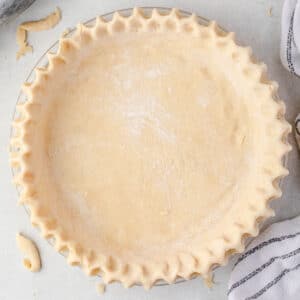
Butter Vodka Pie Crust
Recipe by:Ingredients
- 2 ½ cups (325 grams) flour
- 1 teaspoon (6 grams) table salt
- 2 tablespoons (24 grams) granulated sugar
- 1 cup (227 g) cold unsalted butter, cut into ¼-inch slices (2 sticks, 16 tablespoons)
- ¼ cup (60 ml) ice water
- ¼ cup (60 ml) cold vodka
Instructions
- Place half of the flour (1 ¼ cups) in a food processor, along with the salt and granulated sugar. Pulse a couple of times to mix.2 ½ cups flour, 1 teaspoon table salt, 2 tablespoons granulated sugar
- Add the cold butter slices and pulse about 15 times, using one-second pulses, until small chunks form. Scrape down the sides, then add the remaining flour. Pulse 5-6 times.1 cup cold unsalted butter, cut into ¼-inch slices
- Transfer the dough to a medium bowl. Drizzle the water and the vodka across the surface of the dough, then use a rubber spatula to fold and press the liquids into butter and flour. The dough will be shaggy. Press the crumbs into the dough. If they stick together then you do not need additional liquid.¼ cup ice water, ¼ cup cold vodka
- Split the dough into two balls and flatten each into a round disk. Wrap each disk individually in plastic wrap and refrigerate for 2 hours.
- Remove the pie crust from the refrigerator set the disk on a well-floured surface. Use a rolling pin to create a circle of dough that is ⅛-inch thick. Use additional flour, if needed, to keep the dough from sticking to your rolling pin.
- Transfer the dough to your pie plate and fold the excess dough under to create a rim around the edge of the pie plate. Crimp using your preferred style. Place in the freezer for 10 minutes before baking.
- Bake at 425°F (220°C) for 15 minutes with pie weights, then reduce the temperature to 350°F (180°C) and remove the pie weight. To blind-bake (par-bake) the crust, continue to bake it for an additional 5 minutes. For a fully baked crust, bake for 15 minutes, or until the bottom of the crust is golden brown.
Video
Notes
- It is normal for the dough to have crumbs. Use the plastic wrap to press the crumbs into the dough while forming the disk.
- If you press the crumbs into the dough and they stick then no additional water is needed.
- The dough will continue to hydrate in the refrigerator as the butter is absorbed into the flour.
- Do not skip the step of freezing the pie for 10 minutes. This re-chilling is necessary for the butter to solidify after rolling.
- I use 4 packages of pie weights so that the pie plate is almost completely full. This helps prevent the dough from sliding.
Nutrition
The nutritional facts provided are only estimates. The accuracy of the nutritional information for any recipe on this site is not guaranteed.
This recipe is adapted from Cook's Illustrated.

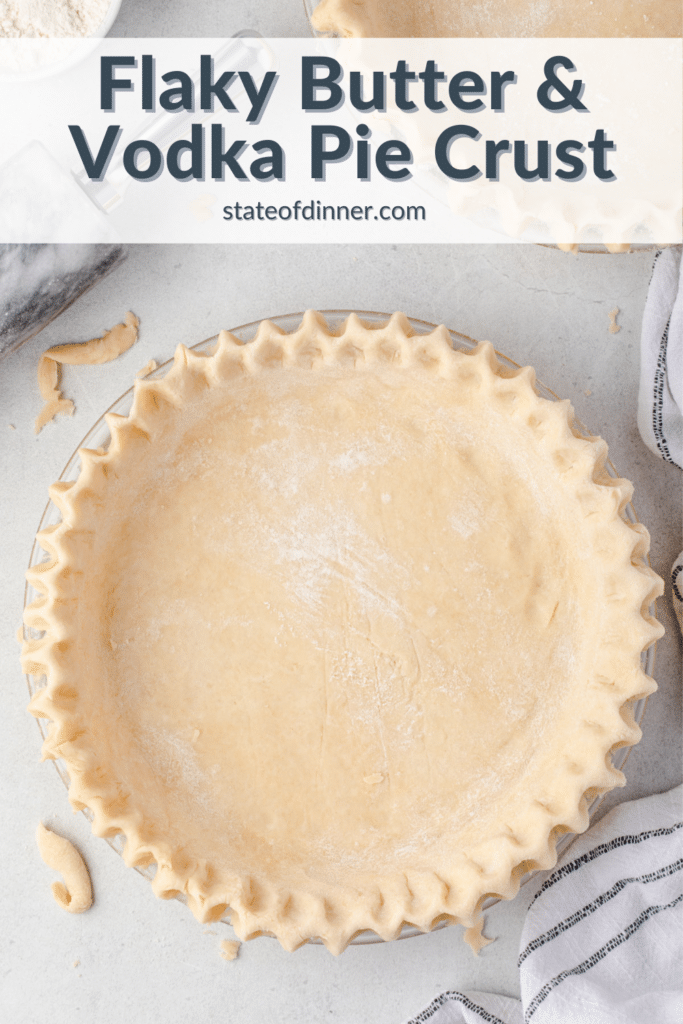
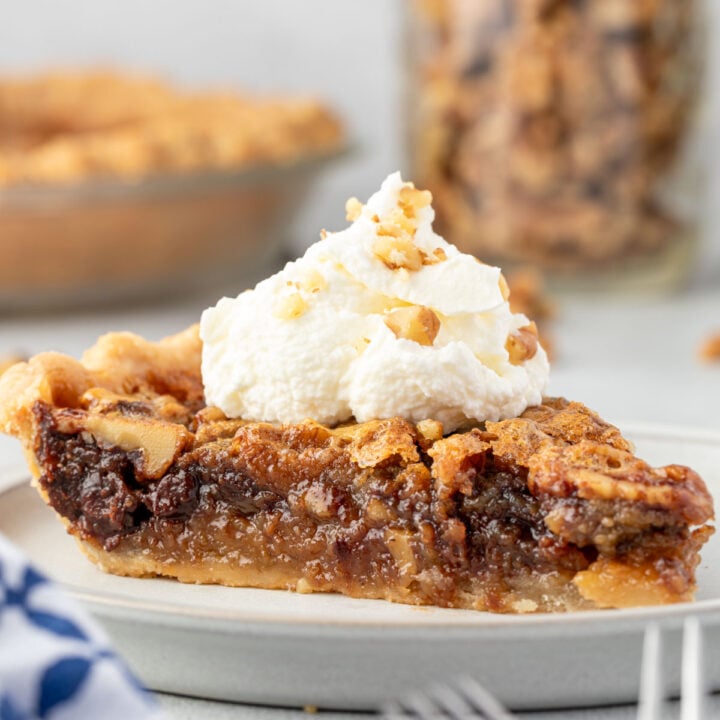

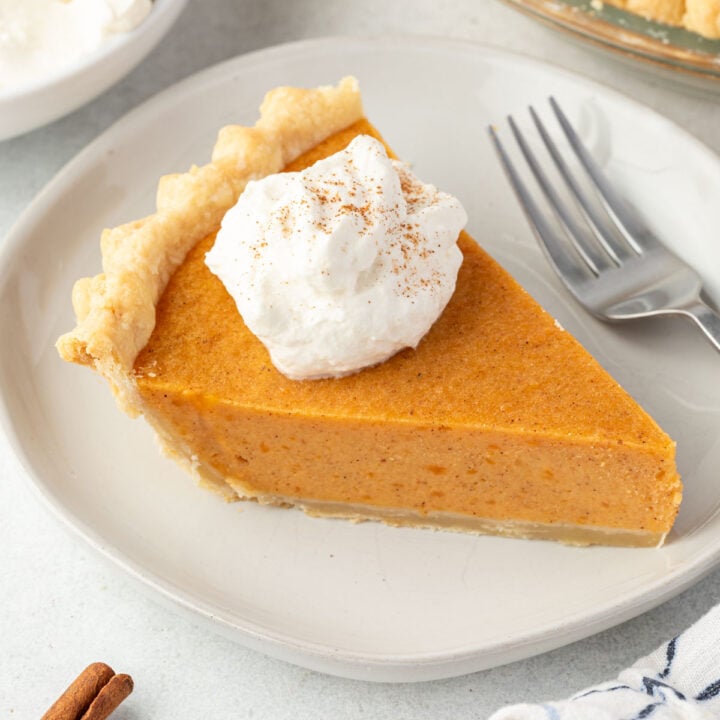
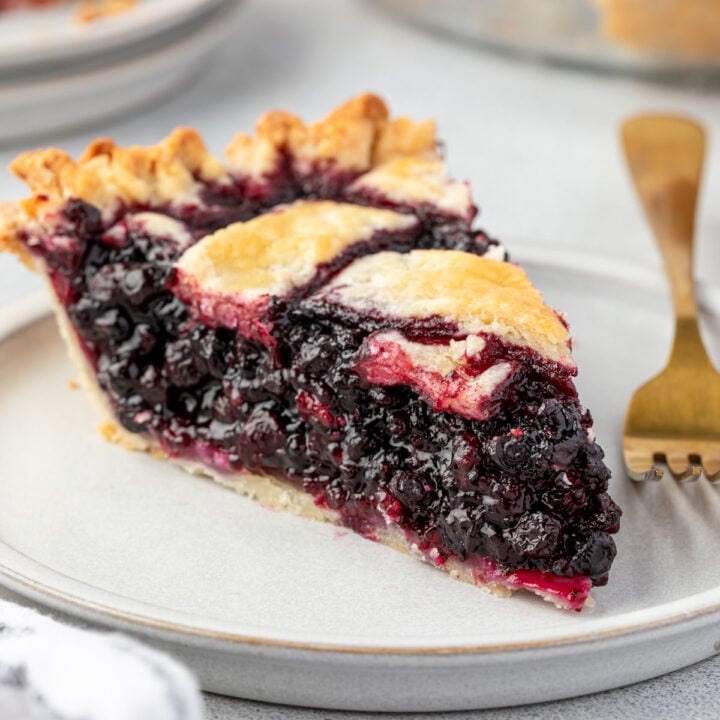
Margi Prueitt says
I am making a pecan pie the calls for unbaked pie crust. Does this sill need to be baked in advance of adding pie filling? I have always made home made crust, but am excited about this one being different (and simpler than my standard).
Erin says
If the recipe calls for an unbaked crust then there is no need to blind bake it before adding the filling. Do still freeze the crust for at least 15 minutes before filling and baking. Enjoy!
Gracie says
I've read some of the comments for this pie dough. I'm thinking maybe the butter hasn't been incorporated enough. Also pinch the dough after you add your liquids. If it holds, it's enough water. If it dosent add a teaspoon at a time until it does. That said, I make a ton of pies, and tried this crust because I've never used Vodka and it is amazingly flaky. This is a keeper. Great recipe!
Erin says
These are great tips, Gracie! You are 100% correct. Thanks for sharing!
Helen says
Can I use rum instead of vodka?
Erin says
I have not tried rum but have heard from readers that it works well.
Stacey says
It’s just ok. I’ve tested other pie recipes and had way better success. The crust ended up very dry and crumbly even after adding the stated amount of liquids. I think that adding the liquids while the dry ingredients are in the food processor would have been way easier. Overall disappointed in this recipe- won’t be using again.
Erin says
Hi Stacey! The reason I recommend adding the liquids by hand rather than with a food processor is so the dough does not get overworked. This is really important in ensuring a flaky crust, as it keeps the gluten formation at a minimum. Additionally, the dough should be crumbly after the correct amount of liquids is added, provided the dough sticks together when you press it. It continues to hydrate during the refrigeration period.
Kim says
I love how you crimp your pie crust, would it be possible to show how you do iit
Erin says
Hi Kim! Thank you so much! It's a really easy process where I pinch with two fingers on one hand and push in with one finger on the other hand. I will make a video and will email you when it's posted.
Amanda says
So much better than storebought! I am usually the person who eats the filling out of my pie slice and tosses the crust. This crust is too good to toss. So flakey and flavorful, and all the tips in the blog post are super helpful for a non-baker like myself. Thanks, Erin!
Erin says
It thrills me to know that you enjoyed this pie crust so much! Thank you, Amanda, for taking the time to share!
Fox says
Made as written. Yum. Certainly the best recipe I’ve ever tried. This Will be the only recipe I ever make. I’m in my seventies and gave up making home made crusts decades ago. Mine we’re not as good as store bought. Now my home made pies will be really home made. Thank you for sharing such a precise recipe.
Erin says
I love to hear that and am so glad that you can now enjoy making 100% homemade pies!
Julia says
I’m kind of confused… I’ve made this recipe twice and after adding both the vodka and water it is still sooooo dry. I’ve had to double the amount of liquid. I’ve made sure to weigh my flour and have followed the process exactly. Any ideas why this could be?
Erin says
Hi Julia! I am so sorry that you have experienced challenges! The most common culprit for dry dough is using too much flour, but if you weighed the flour then here are some other possible causes. 1) Not enough butter. You can weigh your butter too (226 grams). And make sure it is processed to tiny crumbs. After processing does it look like the first photo under the instructions in the post? Or is it drier? 2) Different types of flour absorb water differently, so make sure to use all-purpose flour. 3) If you live at high altitudes or in a dry climate that may impact the amount of water needed.
Jill says
I had the same problem. Very dry dough so I had to almost double the amount of liquid. My measurements were exactly as written. I live in a wet climate at 200 feet and used all purpose flour. I'm not sure why it was so dry.
Erin says
Hi Jill! The dough will be pretty crumbly initially. It doesn't come together just by mixing. You do need to press the dough to form it. I added some additional notes in the recipe card to help you determine whether or not additional liquid is needed. You can also take a look at this video and you can see the texture. https://www.youtube.com/shorts/NbFH4yYHjhg
donna says
what can i use instead of vodka
Erin says
You can use additional water in place of the vodka. Start with 1 additional tablespoon of water (so 5 tablespoons total) and add an additional tablespoon at a time (up to 8 tablespoons/a half cup total) until the dough starts to come together.
Julie Lynn Whitney says
Did I miss the amount of vodka? How much do you use?
😜
Erin says
Yep! It's the last ingredient listed in the recipe card. 1/4 cup. 😀
Shawn Rogers says
This is the best pie crust recipe I have ever found it's a 15 out of 10
Erin says
What a compliment! So glad that you love this crust, Shawn!